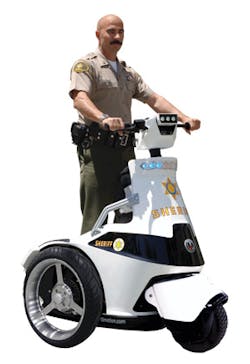Strikes. Outs. Blind mice. Goldilocks' bears. The Holy Trinity. Wise men. Plenty of familiar things come in threes.
Though it is new to the job compared with the rules of American's favorite pastime, our borrowed fairy tales and biblical references, three-wheeled transport vehicles for specialized patrol are establishing themselves within the niche three wheels at a time.
At less than 10 years old, three-wheeled patrol vehicles have become effective patrol tools that can make up the difference where other means of transport lack. Manufacturers say there are multiple reasons why three-wheelers make sense — size, stability, maneuverable electric-powered speed and ability to circumvent greater-wheeled restrictions, to name a few.
The three-wheel platform
Considering the multitude of tasks patrol officers perform, the alternative vehicle makers took a note from Goldilocks. A three-wheeled transportation model fills the gap between the four-wheel patrol car and the two-wheel motorcycle. For some purposes, like crowd control or campus patrol, four-wheel cars may be too big and may not safely (or legally) enter certain areas. Two-wheel units like bicycles or scooters can be less stable than four-wheels, lack visibility above a crowd, require rider exertion to operate and are sometimes ignored. However, three-wheel units address these limitations and for some beat patrol scenarios, fit just right.
One characteristic particular to three-wheeled fleets is how the Department of Transportation classifies them. T3 Motion's CFO Kelly Anderson says the company's electric standup vehicle (ESV) is able to circumvent some of the more rigid rules and regulations to which four-wheeled vehicles are held, meaning the vehicle can cover more ground than cars and more quickly than bikes.
"It's kind of a unique niche space in the Department of Transportation, where it's not classified as a car," Anderson explains. "[Manufacturers] can get it to market and you don't [need] all the crash testing." She also says that because the vehicles are three-wheeled, riders don't need a motorcycle license.
Multiple vendors credit the original personal mobility vehicle company, Segway, with developing the two-wheeled electric vehicle and showing everyone that there was a market for personal transportation units.
"Segway's been out there for awhile and they've got a really great product, but we need something that actually fits for law enforcement," Anderson says. "And so that's when the light bulbs went off that it was probably the right time to start getting into the electric vehicle space."
Trikke Tech Inc. CEO John Simpson agrees. "My hat's off to Segway for showing us the way, [that] this market actually exists. They've done a great job in educating us."
Manufacturers also say three-wheelers add a dimension to the patrol beat that bicycles and horses cannot; they're out of the ordinary, inspiring curiosity and interest. These factors can help police-community relations and make officers on units more approachable.
"Say you're in a crowded area with a bicycle," Anderson says. "People don't move out of the way for bicycles. So you're out walking your vehicle. The T3 is iconic looking. People move out of the way."
Three-wheel single-person patrollers are smaller than cars, giving officers the ability to get into spaces bigger transport cannot.
Neil Roth, president and CEO of Xtreme Green, explains the company incorporated elements from motor vehicles while considering size and durability.
"We decided to make an aluminum-welded frame similar to what you would do in a car, but add suspension, forward and reverse … and make it small enough so riders can still go in and out of elevators and doors," Roth says.
Most three-wheeled vehicles offer various speeds of travel from 5 mph to 29 mph, some allowing the owner to set the top speed depending on the placement and use of the unit; for example, units used indoors for building security are often set at a lower speed than units deployed at a rural campus or crowd-control event.
Intuitive ride
T3 Motion's law enforcement series models boast stability, clean energy and ease-of-ride. Unlike two-wheeled Segway units that are specially engineered to maintain balance and operate responding to rider movement like leaning, T3 units operate via a handle throttle much like a motorcycle, and have controls for signaling and sirens much like a car, thus it takes riders less time to orient themselves.
Simpson says it makes sense to put beat patrol officers on the T3 models because the electric-powered unit lets law enforcement cover more ground with less fatigue than walking or biking. "They try to say their average route is about 8 miles a day, which is a lot. You start having issues with your feet, your knees, and your back ... in addition to the 20 pounds of equipment you're carrying," Simpson says. "[T3 units are] designed to make people do their job more efficiently, faster." She adds that units are iconic in the sense that they show officers have a presence with security, but are not threatening. "The T3 transport model really crosses over that path into community policing, where people come up and talk to you; they engage you as a law enforcement officer, which is what law enforcement wants," Simpson adds.
In 2007, the first year the company began selling the units, T3 Motion won the Cygnus Law Enforcement Group's Innovation Award in the vehicles category for its stable platform and maneuverability.
"Where all electric companies struggled is [when] people looked at it, they loved what it could do, but because we didn't have very many out there and we didn't have our service record on them [yet]," Simpson explains, police were hesitant. T3 says over the last nearly three years, the company's products have gained acceptance, are seen as less of a novelty and have crossed a line to a need-to-have product.
T3 Motion vehicle versions cost approximately 10 cents of electricity per day, provide swappable batteries eliminating downtime, user-selectable speeds between 6 to 25 mph, headlights, and have a weight capacity of 450 pounds.
Additionally, the company claims the electric unit can save thousands of dollars a year by replacing gas-powered vehicles, and can help reduce the carbon footprint of a patrol fleet.
Considering the environment
Another company has recently made a contribution to the personal mobility market: Xtreme Green Products. Xtreme Green is an eco-vehicle company manufacturing the Sentinel Police Mobility Vehicle, an electric vehicle for security and law enforcement.
Roth, who with his partner spent years perfecting the power supply and operation software for the unit, says their goal was to create an electric unit that performs just as well — or better — than gas-powered vehicles.
When the company entered the electric personal transportation market, it heard several requests from law enforcement for improvement on other police-specific transportation that included everything from better headlights, police lights, siren system, and requests for a built-in cell phone charger, shock absorber system, and a better glove box. Officers also said they'd like a place for their flashlights. Xtreme Green responded to those notes and incorporated them into the Sentinel.
The vehicle's three-wheel design and size allow officers to patrol on sidewalks safely, go through open doorways and climb 6-inch curbs when in pursuit.
The company explains all Xtreme Green Products vehicles are designed with energy management systems and electric propulsion systems, giving each vehicle the power and ability of gas powered engines, but without the particulate or noise pollution.
From the police motorcycle, the Sentinel upright and the four-wheel ATV and UTV, Xtreme Green's electric law enforcement line of vehicles covers all the different niches that law enforcement may need, Roth says.
Roth explains the electric motorcycle is not a highway motorcycle, but a street motorcycle that will reach 65 mph, and the ATVs and UTVs are used in more of the rural and wooded areas. The 6.5-foot long Electric Police Motorcycle can go approximately 100 miles per charge, depending on speeds driven during operation.
Xtreme Green by name is taking initiative to be a part of the greening movement to create clean energy. Roth explains his company's models do not require oil changes and have no automatic transmission fluids.
"If you take the police motorcycle and compare that to another motorcycle, there are 90-percent less moving parts than say a Harley," Roth says. "There's just a total reduction in service requirements." The company estimates it costs about 1 cent per mile to operate.
New niche: Carving vehicles
Another three-wheel vehicle now available to law enforcement began as a recreational sporting good: the Trikke Tribred, originally a human-propelled unit, looks like a mash up of a bicycle and skis. Company CEO John Simpson, who came from the sporting goods industry before joining Trikke, says the units are different from what might be considered a traditional three-wheel electric transportation unit. He explains the Tribred moves with the rider and is lightweight and portable, differentiating it from other alternative patrol options.
Trikke's has sold more than 400,000 of the human-powered version since 2002 worldwide. Simpson says it wasn't until about a year and a half ago that the company started adding electric power supply and a hub motor to the unit.
"It was just kind of a no-brainer putting power on our three-wheel platform. Since we've started doing that, we realized we've got a lot of different markets we can go after with the powered vehicle like the police market and the security market, large corporate campus transportation and green consumer transportation. But what people really seem to like about our option is its portability. It only weighs a little over 40 pounds and you can fold it up and put it into the trunk of your car."
A rider stands on the foot platforms that are connected to the front and as one turns on the unit, the arms will tilt, too. So as one turns, or "carves" as the company calls it, the frame leans with a rider.
"It's all very fluid," Simpson says. "The frame is right where you want it to be. The same goes for the electric [Trikke version]; you're just throttling with the right hand and the frame is right with you as you carve your turns."
On the two-wheel front, Segway announced two new Patroller models last May. The company says Patroller models are identifiable by their highly reflective surfaces and an integrated lighting system. Additional product enhancements in the new generation include a newly designed LeanSteer frame, a front bag designed to carry officers' cargo, and an upper shield for affixing the organization's insignia.
On patrol
Over the last decade alternative lightweight patrol units have carved their way into the patrol fleet. Anderson explains that in the beginning, the specialty vehicles were seen as novelties. And while they did attract a lot of attention at law enforcement trade shows, some reluctance persisted because the models were still new. However today's vehicles have been on patrol long enough for officers to experience results, and have transformed the personal mobility patrol vehicle from novelty to need-to-have.
In some ways, three-wheelers still compete with other transportation outside a patrol car, such as bicycles and horses. But given their utility, increasing affordability and growing environmentally savvy "green" contribution, three-wheel models have become a better beat tool.

Tabatha Wethal | Editor
Award-winning writer Tabatha Wethal is a previous editor leading Law Enforcement Technology magazine and assisted with other publications. She was with the magazines since 2007.



